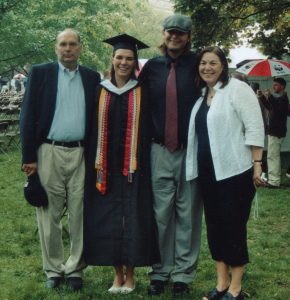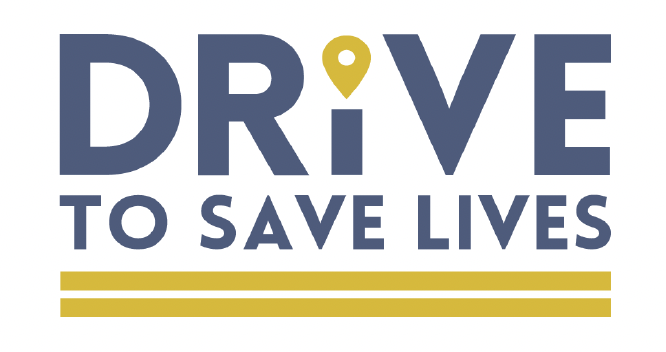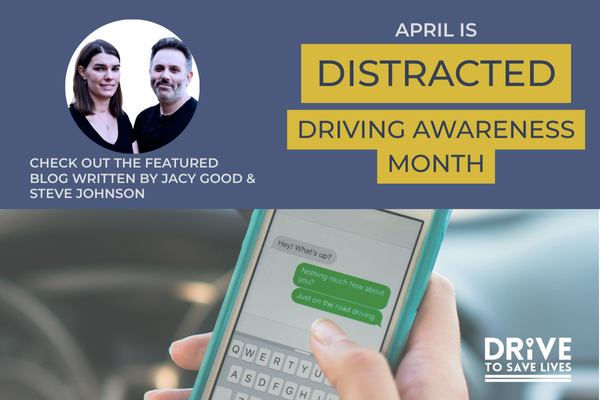This featured blog is written by Drive to Save Lives speakers, Jacy Good and Steve Johnson. In this blog, Jacy shares her powerful story of loss, resilience, and advocacy to highlight the life-altering consequences of distracted driving and inspire change.
April is distracted driving awareness month.
But for people like me, distracted driving is something I am aware of every moment of every day.
 At 21 years old I lost both my parents, Jay and Jean – and almost my own life – at the hands of a cell phone distracted driver. After months in the hospital and with brain trauma, I slowly came to understand the loss of mom and dad and was then forced to spend years relearning how to live life with a paralyzed left side. Suddenly the things I loved to do and the life I had dreamt of living were nothing more than a memory.
At 21 years old I lost both my parents, Jay and Jean – and almost my own life – at the hands of a cell phone distracted driver. After months in the hospital and with brain trauma, I slowly came to understand the loss of mom and dad and was then forced to spend years relearning how to live life with a paralyzed left side. Suddenly the things I loved to do and the life I had dreamt of living were nothing more than a memory.
Unfortunately, this story repeats itself every single day. Hard numbers are tough to come by, but safety organizations estimate that, every day, somewhere close to 1,000 people are just like me – injured because of cell phone use on our roads.
For me that means the simple things in life that I once took for granted are newly difficult. I am proud to say that I can live a pretty normal, independent life. It might look different than I thought it would, but I have worked hard to build an extremely meaningful and purpose-driven life.
Despite this somewhat tough hand of cards I was dealt, I do my best to never forget how lucky I am. I woke up this morning, I took a shower, I got dressed, I made a ponytail (with one hand!). I haven’t figured out how to ride a bicycle again, but I can ride a stationary bike. I can’t run the 5ks I used to love, but I walk my 10,000 steps almost every single day. I may not be the mom I once imagined I would be by now, but I love being an aunt and spending my days guiding high school students on their paths to being safe new drivers. I love this life and I’m so grateful to all the people and organizations that have allowed me to share my life story and safe driving message with their communities.
It’s not what I expected, and some days are harder than others, but I really believe every one of us can always be on the lookout for silver linings and build beautiful things, even out of our most significant setbacks. That is why my husband Steve and I are on the road, sharing our story through our Hang Up and Drive presentations. This next part of the blog is written by Steve to share more about what that journey looks like for us.
Hi everyone! Steve here.
April is a busy month for most speakers working in teen safety. It’s prom season. Graduation is getting pretty close too. But, as Jacy has mentioned, April also happens to be Distracted Driving Awareness Month, and Jacy and I tend to give a whole lot of our Hang Up and Drive presentations in that 30-day stretch each year!
There are speakers who have survived crashes, speakers who have lost loved ones, speakers who were the caregivers of survivors. But sadly (yet powerfully) the two of us together hit all three of those aspects, and we’ve run with it.
The truth is, when we began doing what we do, I was only involved because Jacy was still too physically and cognitively injured to do it on her own. In fact, I did more than half the talking, even though it’s Jacy’s story. Over time she healed more and we swapped the ratio of talk-time to where it belonged. But we kept the duo format because we realized that, aside from keeping it a bit more of a dynamic presentation, we were able to offer something valuable thanks to our intersecting perspectives.
We do our presentation, followed by a Q&A, and then we always tell the audience that they can come talk to us one-on-one if they’d like. Inevitably, a handful of students will want to talk to Jacy, but some (always fewer, she’s the star of the show!) will want to talk to me specifically. They’ll often share something that happened to a loved one and how they connected with my role in our story.
It means so much to me. I love our job. I hate that we have to do it, that we have this story at all. But we can’t change that part. All we can do is get out there and try to connect with people, get them to sympathize, maybe to empathize, get them to not want to use their phones behind the wheel because we’ve gotten them to think about being in a crash…or losing someone in a crash…or sticking by someone who has. I joke that I’m Jacy’s Second Fiddle, but I wear it proudly too. I’ll lift her up in every way I can because nothing makes me prouder, but being able to give a little of the other side – and seeing it connect – is what keeps me motivated during our busiest presentation seasons.

